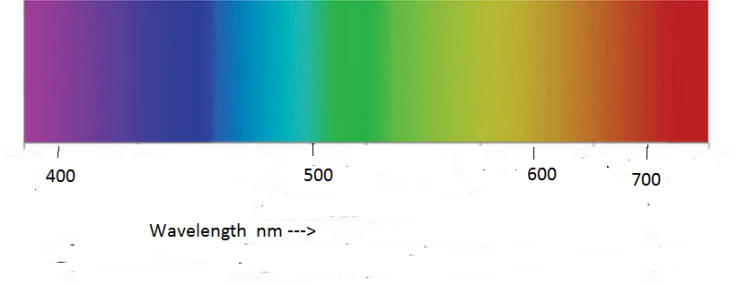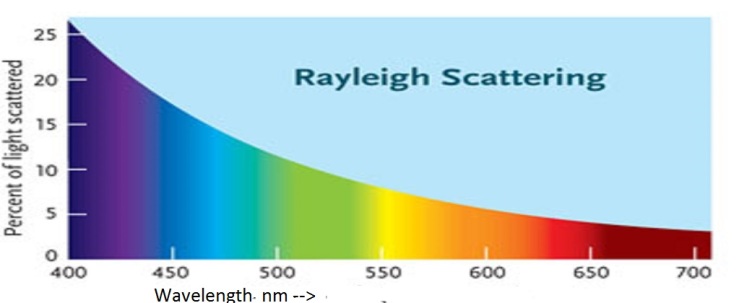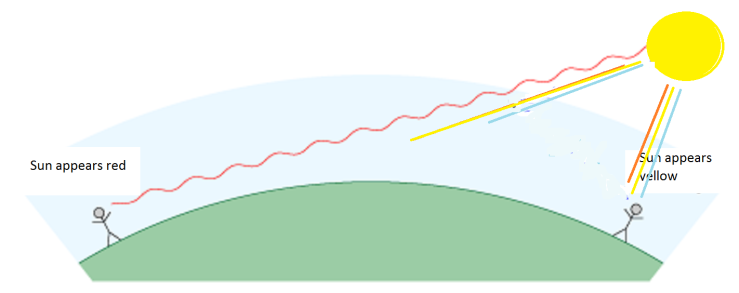Today I want to give the scientific explanation for something we all love to see (especially if, like me, you live in a place as rainy as Manchester, England) – the blue sky. I will also discuss the colour of the skies on the Moon and Mars, two places where spacecraft have landed and taken photographs of their surfaces and skies.
A very rare event. A blue sky over our back garden!
The nature of light
You may remember from your high school science lessons that light is a form of electromagnetic wave.
The diagram above shows a wave of light. The blue lines show the strength of the electric field. See note 1. The wavelength is the distance between successive peaks, marked as A in the diagram, or successive troughs, marked as B in the diagram. The wavelengths are so small that they are usually measured in nanometres (normally abbreviated to nm). 1 nm is equal to one billionth of a metre. The human eye is sensitive to light with wavelengths in the range of 380 nm to 750 nm and we see different wavelengths of light as different colours.
As shown in the diagram the eyes sees wavelengths of
- 380 nm to 430 nm as violet
- 430 nm to 450 nm as indigo (a deep blue)
- 450 nm to 500 nm as blue
- 500 nm to 570 nm as green
- 570 nm to 600 nm as yellow
- 600 nm to 630 nm as orange
- 630 nm to 750 nm as red
Most sources of light, including that from the Sun, produce light waves with a mixture of different wavelengths. If the amounts of light at different wavelengths (or colours) are present in roughly equal proportions then the eye sees the mixture of colours as white.
Scattering of blue light
In the late nineteenth century the British physicist Lord Rayleigh (1842-1919) explained a phenomenon which is now called Rayleigh scattering.
Lord Rayleigh
Rayleigh was able to show that when a beam of light, such as that from the Sun, passes through the air then a small amount of the light is scattered in all directions when it interacts with the individual molecules in the atmosphere. This is shown in the diagram below. See note 2.
Furthermore, he was able to show that the fraction of the energy in a beam of light which is scattered depends on two things:
- Firstly, the number of air molecules the beam of light encounters. The more air molecules or the greater amount of atmosphere which the light beam encounters, the greater the scattering.
- Secondly, the shorter the wavelength of the light the greater the scattering. So if we take a beam of light such as that from the Sun, which contains multiple colours, then the shorter wavelengths (violet, indigo and blue light) are scattered more than the longer wavelengths such as orange and red. This is shown in the graph below.
This explains why the sky is blue. The blue sky we see is the blue light from the Sun which is re-emitted by the air molecules in all directions by Rayleigh scattering. One other thing that the diagram shows is that violet light has a shorter wavelength than blue and it is scattered even more. However, the Earth’s sky is not violet. This is because the strength of the Sun’s light isn’t the the same at all wavelengths. It contains relatively little violet light compared to blue. So, although violet light is scattered more in percentage terms than blue light, there is less violet light to scatter.
One other effect of scattering is that it makes the colour of the Sun to an observer on Earth appear to be yellow-orange, rather than white. Although the balance of the colours is such that the Sun’s light is white as it leaves the Sun’s surface, when it encounters the atmosphere scattering removes from direct sunlight a greater amount of the shorter wavelengths (violet, blue and green) than the longer wavelengths (yellow, orange and red) and the resulting mix of colours appears to be yellow rather than white. Interestingly, when astronauts view the Sun from space well above the Earth’s atmosphere it appears to be white.
Near sunrise and sunset, when the Sun is at a low angle in the sky, just above the horizon, the Sun’s rays have to pass through many hundred of kilometres of atmosphere before hitting the Earth’s surface. Because the Sun’s rays pass through much more atmosphere, the degree of scattering is much greater than when the Sun is higher in the sky at midday.
As shown in the table below, virtually all the shorter and medium wavelengths of light, (blue, green and yellow coloured light) are removed from the Sun’s rays, leaving only the longer wavelengths (orange and red). This explains why the Sun appears red near sunrise and sunset.
The sky on the Moon
The Moon has no atmosphere. Therefore there is no Rayleigh scattering of sunlight and the sky appears completely black during the day. The Sun appears to be whiter in colour because the shorter wavelengths are not removed from its light as they are on Earth.
Image from NASA
One interesting effect of having no atmosphere is that the Apollo astronauts who walked on the Moon found it very difficult to judge how far away objects were. On Earth, the atmosphere causes distant objects look slightly hazy, but this is not the case on the Moon. For example, astronauts were unable to estimate whether what appeared to be a hill was a small object 100 m high only 1 km away or a 2 km mountain 20 km away.
The sky on Mars
Mars has a very thin atmosphere. The air pressure on Mars is only 0.7% of that on Earth. There is far too little atmosphere for Rayleigh scattering to be an important effect. Indeed before the first space probes landed on Mars back in 1976 many space scientists expected that the sky on Mars would be black. In fact the sky on Mars is a pale reddish brown colour. This is due to small particles of reddish brown iron oxide dust suspended in the Martian atmosphere.
The surface of Mars – Image from NASA
Notes
- Light also has a magnetic field which is always at right angles to the electric field. To simplify the diagram this is not drawn. The Scottish physicist James Clarke Maxwell (1831-1879) worked out the theory of how electromagnetic waves (which of course includes light) propagate. This theory uses two of the four Maxwell’s equations which are studied by all physics undergraduates.
- The mathematics behind Rayleigh scattering is too detailed to go into in this post. The link below gives more information:
http://hyperphysics.phy-astr.gsu.edu/hbase/atmos/blusky.html
Post updated 17 June 2020










[…] gentle, i.e. violet, indigo and blue, by air molecules (I’ve described this in my earlier submit Why is the Sky Blue? ). On the Moon there isn’t any ambiance to scatter daylight, so the sky is totally black […]
LikeLike
[…] light, i.e. violet, indigo and blue, by air molecules (I’ve described this in my earlier post Why is the Sky Blue? ). On the Moon there is no atmosphere to scatter sunlight, so the sky is completely black in the […]
LikeLike
[…] light, i.e. violet, indigo and blue, by air molecules (I’ve described this in my earlier post Why is the Sky Blue? ). On the Moon there is no atmosphere to scatter sunlight, so the sky is completely black in the […]
LikeLike
Ah, light! Ah, (human) perception! Ah, sky! Ah…. Earth! 🙂
LikeLiked by 1 person
[…] by the Earth’s atmosphere by a process called scattering, which I discussed in an earlier post https://thesciencegeek.org/2015/09/30/why-is-the-sky-blue/ . The same effect causes the western sky to be red after sunset on a clear […]
LikeLike
Not todsy
LikeLike
[…] the Earth’s ambiance by a course of known as scattering, which I mentioned in an earlier submit https://thesciencegeek.org/2015/09/30/why-is-the-sky-blue/ . The identical impact causes the western sky to be pink after sundown on a transparent […]
LikeLike
[…] the Earth’s ambiance by a course of known as scattering, which I mentioned in an earlier submit https://thesciencegeek.org/2015/09/30/why-is-the-sky-blue/ . The identical impact causes the western sky to be pink after sundown on a transparent […]
LikeLike
[…] by the Earth’s atmosphere by a process called scattering, which I discussed in an earlier post https://thesciencegeek.org/2015/09/30/why-is-the-sky-blue/ . The same effect causes the western sky to be red after sunset on a clear […]
LikeLike
[…] by the Earth’s atmosphere by a process called scattering, which I discussed in an earlier post https://thesciencegeek.org/2015/09/30/why-is-the-sky-blue/ . The same effect causes the western sky to be red after sunset on a clear […]
LikeLike
[…] the Earth’s ambiance by a course of known as scattering, which I mentioned in an earlier publish https://thesciencegeek.org/2015/09/30/why-is-the-sky-blue/ . The identical impact causes the western sky to be pink after sundown on a transparent […]
LikeLike
[…] by the Earth’s atmosphere by a process called scattering, which I discussed in an earlier post https://thesciencegeek.org/2015/09/30/why-is-the-sky-blue/ . The same effect causes the western sky to be red after sunset on a clear […]
LikeLike
[…] Within the dialogue of magnitudes all of the values quoted are visible magnitudes. That is how vivid the objects are in mild of wavelength of 540 nanometres, which is within the inexperienced a part of the spectrum. The values at different wavelengths will likely be totally different for various objects. For particulars on mild and the best way the attention sees totally different wavelength as totally different colors see https://thesciencegeek.org/2015/09/30/why-is-the-sky-blue/ […]
LikeLike
[…] In the discussion of magnitudes all the values quoted are visual magnitudes. This is how bright the objects are in light of wavelength of 540 nanometres, which is in the green part of the spectrum. The values at other wavelengths will be different for different objects. For details on light and the way the eye sees different wavelength as different colours see https://thesciencegeek.org/2015/09/30/why-is-the-sky-blue/ […]
LikeLike
[…] giving the sky a faint glow. The mechanism for this is described in more detail in a previous post Why is the Sky Blue? As the Sun moves further below the horizon its rays can only reach the very uppermost reaches of […]
LikeLike
informative blog ! -.. I’m following
LikeLike
I am now
LikeLike
Great, but what’s the version you tell a 5-year-old?
LikeLike
A really interesting point. I think there is a definitely a need for a Understanding Science for 5 year olds blog.
The Science Geek
LikeLike
Hello! thank you for liking my recent post. I would like to ask a question about the blue of the sky please. As you mention , blue is what we “see” when exposed to certain wavelengths of light. This implies that the “seeing” occurs in the brain, outside the brain or perception there is only electromagnetic radiation, “blue” or any other colour only ever occurs in the brain. If that is so, then is it not also true for all light. In other words all the light we have ever seen exists only in the mind, although it may result from an “external” stimulus. If that is so, what is the nature of light as an experience? Is this not also true for all experience? Please correct me, for the outcome of this kind of reasoning, and I believe it is reasonable and hence true, is that all reality is in fact mind. Thank you, from sunny Rome, please feel free to visit, I am a displaced northerner myself (born in Leeds, childhood years in Settle), so I sympathize. Best wishes, Nemir
LikeLike
Thank you Nemir for your interesting and somewhat philosophical comment. I envy you being in sunny Rome. A clear blue sky in Manchester is such a rare occurrence that I thought I would write a post about it 😉
The Science Geek
LikeLike
Dear science geek, sorry I have taken months to reply, although it may appear contrary to reason and how things are, is there not some truth to my observation? If what scientists tell us is correct about the nature of perception, (wavelengths, rods and cones, nerves and neurons), all “Light” is immaginal, i don’t see it as philosophy at all, just seeing things as they are. In fact I have gone further, because if “Light” is immaginal, or any other phenomena, then presumably the same is true for “nerve” and “neuron”, so in a way things return to how they where, each is as it appears to be, except , what they are made of, ultimately is mind, not “matter”, or rather matter is consciousness. Again this may seem unscientific or philosophical, but I have arrived at this conclusion only by observing and reasoning, there is no other explanation. It is sunny again here in Rome, after three cloudy days, With best wishes, Nemir
LikeLike
Very interesting of things I take for granted. So why do stars always appear white no matter their elevation in the sky?
LikeLike
Thanks Jogwo,
I am glad you enjoyed the post. The reason why stars appear white is that at very low levels of light, such as those found in the night sky, the human eye is not able to distinguish colour.
The Science Geek
LikeLike
Also, in conjunction with what the author has said, stars DO have colors. You can determine subtle differences between red-orange stars (like Betelgeuse, for example) with blue stars, e.g., Rigel or Vega. And even a basic camera can capture these differences with a long-exposure shot.
LikeLike
Great post! Now the question is, why do we find it so beautiful?
LikeLike
In depth and well researched post. It brought back memories of Physics class in school.
LikeLike
fascinating! I’d heard why it was blue before but never thought why it turned red at sunset.
LikeLiked by 1 person
Good explanation, and pleased to hear that the sky is blue even in Manchester – sometimes!
LikeLike
I used to do a demo on the overhead projector similar to this video. I thought you might enjoy seeing it. https://youtu.be/LSf7iRD5Jws
LikeLike
An interesting video 🙂
The Science Geek
LikeLike
I am like gregole – I feel like I understand but have difficulty explaining well.
LikeLike
Very interesting! Thank you! Especially the part about depth perception on the moon. It makes total sense.
LikeLike
Thank you for your comment. The other difficulty with estimating distances to objects on the Moon,were that there are no visual clues such as: the sizes of natural objects e.g trees, animals etc or man made objects e.g. motor vehicles, to allow the astronauts to estimate the distances to objects outside their immediate vicinity.
The Science Geek
LikeLike
I was just thinking the exact same thing.
LikeLike
Thanks for the cogent and clear explanation. This is something that I always feel like I understand, but when I’m pressed to put it in words, I realize I can’t thoroughly explain it! And Mars’ sky color – very interesting.
LikeLike